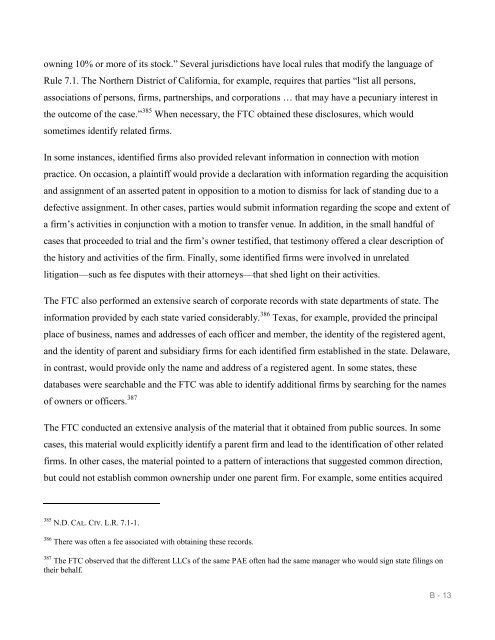You also want an ePaper? Increase the reach of your titles
YUMPU automatically turns print PDFs into web optimized ePapers that Google loves.
owning 10% or more of its stock.” Several jurisdictions have local rules that modify the language of<br />
Rule 7.1. The Northern District of California, for example, requires that parties “list all persons,<br />
associations of persons, firms, partnerships, and corporations … that may have a pecuniary interest in<br />
the outcome of the case.” 385 When necessary, the FTC obtained these disclosures, which would<br />
sometimes identify related firms.<br />
In some instances, identified firms also provided relevant information in connection with motion<br />
practice. On occasion, a plaintiff would provide a declaration with information regarding the acquisition<br />
and assignment of an asserted patent in opposition to a motion to dismiss for lack of standing due to a<br />
defective assignment. In other cases, parties would submit information regarding the scope and extent of<br />
a firm’s activities in conjunction with a motion to transfer venue. In addition, in the small handful of<br />
cases that proceeded to trial and the firm’s owner testified, that testimony offered a clear description of<br />
the history and activities of the firm. Finally, some identified firms were involved in unrelated<br />
litigation—such as fee disputes with their attorneys—that shed light on their activities.<br />
The FTC also performed an extensive search of corporate records with state departments of state. The<br />
information provided by each state varied considerably. 386 Texas, for example, provided the principal<br />
place of business, names and addresses of each officer and member, the identity of the registered agent,<br />
and the identity of parent and subsidiary firms for each identified firm established in the state. Delaware,<br />
in contrast, would provide only the name and address of a registered agent. In some states, these<br />
databases were searchable and the FTC was able to identify additional firms by searching for the names<br />
of owners or officers. 387<br />
The FTC conducted an extensive analysis of the material that it obtained from public sources. In some<br />
cases, this material would explicitly identify a parent firm and lead to the identification of other related<br />
firms. In other cases, the material pointed to a pattern of interactions that suggested common direction,<br />
but could not establish common ownership under one parent firm. For example, some entities acquired<br />
385<br />
N.D. CAL. CIV. L.R. 7.1-1.<br />
386<br />
There was often a fee associated with obtaining these records.<br />
387<br />
The FTC observed that the different LLCs of the same PAE often had the same manager who would sign state filings on<br />
their behalf.<br />
B - 13


